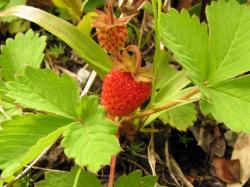UNH Scientists Unravel Genetic Ancestry Of Cultivated Strawberry
August 23, 2016 | 4 min to read

DURHAM, N.H. – Scientists from the University of New Hampshire have unlocked a major genetic mystery of one of the ancestors of cultivated strawberry. A genetic analysis conducted by New Hampshire Agricultural Experiment Station researchers, which took four years to complete, aims to improve modern cultivation efforts of strawberry growers.
The focus of the UNH research is one of cultivated strawberry’s wild ancestors, Fragaria iinumae. Strawberry species have seven unique chromosomes. Like humans, this species of strawberry has two sets of chromosomes, as opposed to the cultivated strawberry, which has eight sets chromosomes and is among the most genetically complex plants. The UNH study relied on samples of this strawberry species collected on the Japanese Island of Hokkaido by an American-Japanese expedition in 2004 that included UNH plant geneticist Dr. Thomas Davis.
UNH scientists, including Davis and experiment station researcher Dr. Lise Mahoney, constructed a linkage map of the seven chromosomes of the diploid Fragaria iinumae, which allows them to fill in a piece of the genetic puzzle about the eight sets of chromosomes of the cultivated strawberry. The cultivated strawberry is believed to trace its genetic ancestry to as many as four diploid ancestral strawberries, one of which is Fragaria iinumae.
“Many people are trying to understand the ancestry of the cultivated strawberry so that they can better understand traits associated with specific genetic markers, such as fruit quality, flowering habits, and resistance to diseases,” Mahoney said. “Defining the genomes of the cultivated strawberry’s wild ancestors will ultimately help guide the use of genetic information in breeding for a better cultivated strawberry.”
The research on Fragaria iinumae is the second time experiment station researchers have mapped the genes of an ancestral diploid strawberry of the cultivated strawberry. In 2011, UNH researchers were part of a team that sequenced Fragaria vesca, another diploid ancestor of the cultivated strawberry. This reference sequence immediately became an indispensable resource in strawberry genetic research throughout the world.
“This remarkable genetic map, which is the highest resolution linkage map for any ancestral diploid strawberry species, is a valuable research tool in and of itself. More importantly, it provides a necessary resource for assembly of a Fragaria iinumae reference genomic sequence as a much needed complement to the previously published reference genome for ancestral diploid F. vesca,” Mahoney said.
To create the genetic map of Fragaria iinumae, experiment station researchers used the IStraw90® strawberry SNP array, an advanced genomics tool for marker-assisted mapping that the Davis lab helped develop as part of the International RosBREED Consortium. Prior to the advent of the marker-assisted mapping approach, breeders had to rely only on the evaluation of physiological traits such as fruit yield, disease resistance, and flavor for hundreds of plants to identify those with the desired traits, while having little or no knowledge of each plant’s underlying genetic composition. The evaluation of traits in very large breeding populations is costly and time-consuming.
“UNH is recognized as one of a very small handful of institutions worldwide working at the forefront of strawberry genomics and its application to strawberry breeding. We are leading a multi-institutional collaboration to assemble a new genomic resource, the F. iinumae reference genome. Of particular local interest, we are putting the genomic knowledge, resources, and technologies to work at UNH to develop new strawberry varieties that will be locally adapted and suitable for organic production, to the benefit of regional strawberry growers and consumers,” Mahoney said.
The researchers present their findings in the article A High-Density Linkage Map of the Ancestral Diploid Strawberry, Fragaria iinumae, Constructed with Single Nucleotide Polymorphism Markers from the IStraw90 Array and Genotyping by Sequencing in the journal The Plant Genome.
The United States is the world’s leading producer of strawberries. In 2012, the United States produced more than 3 billion pounds valued at $2.4 billion, according to the USDA. Most U.S. strawberries are grown in California. Strawberries are also an important crop in New Hampshire, with estimates of the retail value of New Hampshire’s strawberry crops at about $1.85 million.
This material is based upon work supported by the NH Agricultural Experiment Station, through joint funding of the National Institute of Food and Agriculture, U.S. Department of Agriculture, under award number 0220720, and the state of New Hampshire.
Founded in 1887, the NH Agricultural Experiment Station at the UNH College of Life Sciences and Agriculture is UNH’s original research center and an elemental component of New Hampshire's land-grant university heritage and mission. We steward federal and state funding, including support from the USDA National Institute of Food and Agriculture, to provide unbiased and objective research concerning diverse aspects of sustainable agriculture and foods, aquaculture, forest management, and related wildlife, natural resources and rural community topics. We maintain the Woodman and Kingman agronomy and horticultural farms, the Macfarlane Greenhouses, the Fairchild Dairy Teaching and Research Center, and the Organic Dairy Research Farm. Additional properties also provide forage, forests and woodlands in direct support to research, teaching, and outreach.
The University of New Hampshire, founded in 1866, is a world-class public research university with the feel of a New England liberal arts college. A land, sea, and space-grant university, UNH is the state's flagship public institution, enrolling 13,000 undergraduate and 2,500 graduate students.
Experiment station researcher Dr. Lise Mahoney helped construct a linkage map of the Fragaria iinumae. UNH is recognized as one of a very small handful of institutions worldwide working at the forefront of strawberry genomics and its application to strawberry breeding.
UNH scientists constructed a linkage map of the seven chromosomes of the diploid Fragaria iinumae, which allows them to fill in a piece of the genetic puzzle about the eight sets of chromosomes of the cultivated strawberry.
Source: The University of New Hampshire
